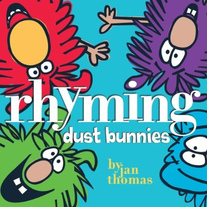 Rhyming dust bunnies by Jan Thomas
Beach Lane Books, 2009
Ed, Ned, Ted, and Bob are four dust bunnies who love to rhyme, and what could possibly interrupt such fun? Bob sees something that might stop their game in its tracks, but whether the other three will listen to what he is saying remains to be seen.
Rhyming dust bunnies is one of my favourite early-elementary books. The illustrations are big and bright in primary and secondary colours, it encourages crowd involvement with the rhyming (what 4- or 5-year-old can resist the question "what rhymes with cat?"), and the plot is ridiculously simple and cleverly executed. Who would have guessed that a book about dust bunnies avoiding a broom could be so funny? Not I.
Thomas creates wonderful tension with Bob, the dust bunny who can't seem to make a rhyme from even the easiest of words. His three friends certainly let him know that his rhyming is not up to par, even when what Bob is saying is, "LOOK OUT!" The audience knows something is amiss from the beginning, and the fun is waiting to see how long it takes Ed, Ned, and Ted to figure it out.
I can attest from personal experience that young children adore this book. When I read it to the grade Primary class last year, they yelled out rhyming words, laughed at the punchlines, and ultimately enjoyed it so much that they demanded I read it again immediately. So I did, and they relished it as much or more the second time. It is a popular book in the library, as it should be.
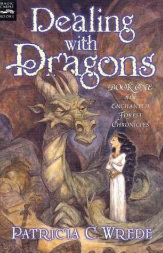 Dealing with Dragons (Enchanted Forest Chronicles - book 1) by Patricia C. WredeMagic Carpet Books (Harcourt), 1990Cimorene is the youngest of the King of Linderwall's seven daughters, and she hates being a princess. In order to avoid royal life and marrying a prince she considers dull, Cimorene volunteers to become a dragon's princess. Although traditionally princes save princesses who have been taken by dragons, Cimorene relishes the relative freedom and becomes caught up in a plot involving wizards, dragons, and a magic stone. Cimorene is a character that might result when the Paper Bag Princess got a little bit older: brave, smart, independent, and with no interest in being rescued by a prince. Cimorene is also perceptive and witty, and I liked her a lot (I imagine it would be quite difficult to dislike Cimorene). I found the vast majority of the characters to be entertaining and consistent, from Alianora to Kazul. Even Moranz was fun. In fact, the my entire experience with Dealing with dragons can be summed up with that word: fun. The plot was suitably thick, the wit was quick, new and unexpected characters were delightful, and I am very much looking forward to reading the rest of the series.
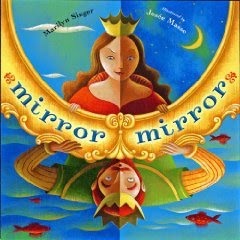 Mirror Mirror: a book of reversible verse by Marilyn Singer, illustrated by Josée MasseDutton Children's Books, 2010Fairy tales are told from two perspectives using the same poem, but read in reverse the second time. Deceptively simple premise, yes? Well, Marilyn Singer has come up with over a dozen pairs of poems that tell parts of fairy tales using the same words and the same lines, in a style she calls reverso. In her words: "When you read a reverso down, it is one poem. When you read it up, with changes allowed only in punctuation and capitalization it is a different poem" (last page of unpaginated book). Amazingly, it really works. I'm glad I read this book today for a second time, because when I read it for the first time last week I wasn't a huge fan of it: it struck me as gimmicky and some of the poems felt awkward. I must have been tired or in a foul mood because today I really enjoyed it. Admittedly, some of the poems don't flow as nicely as I would have liked, but when it clicks all is well in the world. My favourites of the 14 reverso pairs are The Doubtful Duckling and Longing for Beauty, both of which deal with the characters' emotions (the Ugly Duckling and Beauty and the Beast, respectively) as opposed to a description of events. In fact, the reversos in the book generally fall into one of those two categories: description of events and description of characters' feelings. Overall, I felt the ones that addressed emotions were more effective, but that may be my own bias. I must comment on the illustrations by Josée Masse because they are, in a word, spectacular. Each illustration is divided into two to reflect the reverso poems on the opposite page, and Masse creates beautiful links between each pair of illustrations. For example, Sleeping Beauty's skirt blends perfectly into the hills being climbed by the prince coming to save her. The illustrations are luminous, full of rich golds and greens and reds, and combine perfectly with the poems. For young students interested in poetry or fairy tales, this book will open their eyes to a challenging and fun style of writing.
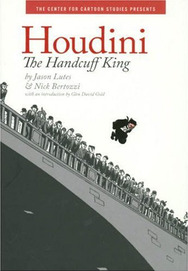 Houdini: the handcuff king by Jason Lutes & Nick BertozziThe Centre for Cartoon Studies, 2007It is 5:00am on May 1, 1908, and Harry Houdini is preparing for a handcuffed jump off of Harvard Bridge in Cambridge, Massachusetts. He checks the police-issued handcuffs, goes for a jog, and reviews the stunt plan with the police and his assistant. With the river almost freezing over and a large crowd expected, Houdini has his livelihood as well as his life at stake. The handcuff king is from the same publisher as my earlier-reviewed Amelia Earhart: this broad ocean, and it bears some striking similarities. Three colours are used in the drawings - in this case black, white, and a grey-blue - and there is a lengthy introduction by Glen David Gold, who wrote a biography about one of Houdini's contemporaries. Also, at the end of the book, there are more than four pages that provide supplementary details about specific panels in the book, from how the locks of the early 20th century worked to promotion and advertising during that time period. In fact, the back matter provides the context needed for this very brief glimpse into Houdini's life. The entire book spans the events of one day , and one stunt, in Houdini's career. It is a snapshot of the man he was, from his adoration of his wife Bess to the control he had over every single aspect of a performance, and an indication of his ability to attract huge crowds to his spectacles. The illustrations were detailed, particularly the crowd scenes, although I found the lettering style distracting. My favourite part of the book was when Houdini is struggling to escape from the handcuffs while underwater, which is shown on the panels at the edge of each page, and the reactions of the crowd and the ticking clock is shown in inner panels. It gives a distinct atmosphere of concurrent events and certainly increased the tension of the moment for me, and I appreciate how the Lutes and Bertozzi take this life-threatening stunt that would be a memorable event in most people's lives, and present it as a common occurrence in Houdini's life. The handcuff king is an accessible introduction to the life of a man that holds mystique for many, and in a format that students will be drawn to and learn from.
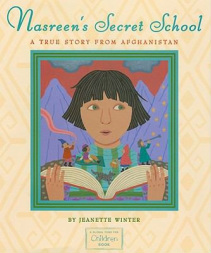 Nasreen's secret school by Jeanette Winter
Beach Lane Books, 2009
Nasreen and her grandmother live alone in Herat, Afghanistan, after Nasreen's father was taken away by Taliban soldiers and her mother has disappeared in an attempt to locate him. It has been many months and Nasreen has not spoken since her father was taken. Although the Taliban does not allow girls to go to school, Nasreen's grandmother wants her to learn about the world as she had so she finds out about a secret school for girls and takes Nasreen. Although it takes many more months, with the help of a friend Nasreen moves past her parents' disappearances and begins to learn.
This is not a light storybook, and Jeannette Winter does an admirable job explaining the Taliban regime and its ramifications on the daily lives of women in a succinct and easily understood manner. The recent history of Afghanistan is very briefly summarized in the first couple of pages, enough to provide context to the story, especially that the Taliban was a new regime and made radical changes to society. The arrival of the Taliban is correlated with a dark cloud settling over the city, and that cloud is visible in the majority of the illustrations. The author's note at the beginning reveals that the Taliban fell in 2001 but that danger still remains, and that girls going to school is still not accepted practice.
Not wholly dark, apart from the cloud Winter's illustrations are generally quite bright and patterned. Nasreen always wears the same clothing which makes it easier to pick her out from the crowd of girls at her school, as do her green eyes, and the pinks, oranges, and greens Winter often uses are a welcome lift from the text.
The idea of having a parent taken away and another disappearing is undoubtedly a scary subject for young children, especially as the book is based on a true story. As well, while the story ends on a happy note, within the confines of the book news of Nasreen's parents is never found and the Taliban is still, presumably, in power. For children who balk at the idea of parents being taken away this could prove to be a bit much, and so I would caution adults to read this book before presenting it to young children.
Nasreen's secret school provides a perspective not often seen in picture books: children who need to avoid mortal danger simply to have the opportunity to learn. Although perhaps scary for some children, it is a book that ends with hope and a positive look to the future, and would be an excellent read-aloud to raise awareness of the continuing plight of women in Afghanistan for older children and teens as well.
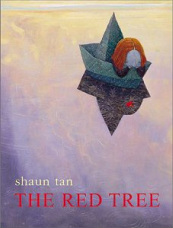 The red tree by Shaun TanSimply Read Books, 2003I unabashedly adore Shaun Tan. It should be noted that this was not the case before I read The red tree. Granted, I think his The arrival is a work of genius, but The red tree spoke to me so vividly that I would probably be struck dumb if ever I was lucky enough to meet him. The premise of The red tree is simple: a young girl wakes up and "...the day begins / with nothing to look forward to / and things go from bad to worse,"* until the end of the day when something remarkable happens. The execution, however, is anything but simple: the illustrations are stunning and the text is spare and poetic. The phrases Tan uses get right to the point, from "nobody understands" to "sometimes you just don't know what you are supposed to do." Hopelessness, fear, and yearning permeate this day in the small girl's life. The illustrations start out simply, with a depiction of the girl getting out of bed taking up about a fifth of the story's initial two-page spread. They do not stay simple however, and scenes straight out of a dark fantasy emerge. From desolate landscapes to massive mechanical dragons and ships in roiling seas, the small protagonist encounters a long sequence of unwelcoming environments. A lone red leaf is with her throughout her day, something that I did not catch until I read the book a second time. Having read two of Shaun Tan's other books - The arrival (2007)and Tales from outer suburbia (2008) - it is fascinating to see how some visual elements from The red tree are also found in those books. For example, one of the earliest scenes in The red tree shows the girl with a large old-fashioned submarine helmet on her head, which is very similar to the helmet found on the cover of an edition of Tales from outer suburbia. While the human characters in The arrival are more realistic in their features, the alien space and objects in The red tree have similarities to the atmosphere in The arrival. This is a book that is, arguably, for older students. While it is as dark as it is beautiful, I would not shy away from having it in an elementary library. However, I believe that older students, especially teens, would get a lot more out of The red tree. As an adolescent I remember often feeling hopeless, misunderstood, and like nothing good would ever happen to me, and anecdotal evidence suggests that many others would agree. The red tree is a beautiful, poignant book that I will purchase for the school libraries I manage, and a thousand thanks to my professor for the recommendation. *Another unpaginated picture book! These lines are the first three lines of the book, but all other quotes in this review will not be given a page reference.
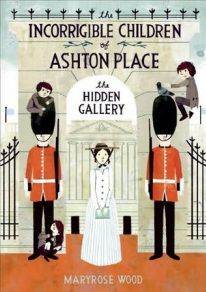 The Hidden Gallery (The Incorrigible children of Ashton Place, book 2) by Maryrose Wood
Balzer + Bray, 2011
Governess Penelope Lumley is off to London with her three pupils - Alexander, Beowulf, and Cassiopeia Incorrigible - and their guardians, Lord and Lady Ashton. Penelope is excited to be able to visit with her beloved former headmistress, Miss Mortimer, and begins planning educational walking tours around the city for herself and the children using the guide Miss Mortimer sent to her. Things begin to go awry as soon as she and the Incorrigibles step off the train, from getting lost to strange proclamations from a fortune teller, but Penelope continues to be optimistic. When a luncheon with Miss Mortimer takes a mysterious turn, Penelope becomes determined to get to the bottom of who may be threatening her beloved Incorrigibles and why they were left in the woods to be raised by wolves in the first place.
The Incorrigible Children of Ashton Place books are spoofs of classic governess novels (such as Jane Eyre) and poke a lot of fun at Victorian life and culture, and this second book in the series certainly delivers on those counts. The fact that the children were actually raised by wolves is a gimmick that is still paying off in The hidden gallery, although I find that the children have stagnated a bit in their development and acculturation. In the first book (which I read a few months ago so have not reviewed here), the children had just been discovered so could not speak human language and were terrified of their new situation. The process of their linguistic and cultural acquisition was handled in a manner that was both charming and hilarious, as were Penelope's reactions to and methods of teaching the children. In this second book, while still charming and often hilarious, the children did not develop very much further. True, they are all clever and learn quickly, whether it's navigation techniques or geometry, but their skills did not seem to improve very significantly. Perhaps it is inevitable that they would not develop as much as during the first book, but more individual character evolution would have been nice to see, as in my mind the three children are almost interchangeable.
This lack of character development does not apply to Penelope, who is earnest and also very clever, if a bit naive. She doesn't shy away from a challenge (if it wasn't already obvious when considering her pupils), even if that challenge is befriending the moody, spoiled Lady Ashton. Indeed, Penelope has the sort of astute intellect that would be a menace if she discovered the powers of sarcasm. The addition of Simon Harley-Dickinson - whose surname I nearly always misread as Harley-Davidson - to the cast of characters was welcome, and I also enjoyed learning more about housekeeper Mrs. Clarke.
There is an entangled mystery to the Incorrigible Children books, and that is why the children were raised by wolves in the first place and what connection Lord Ashton has to them. Penelope is also tied up in all of this as an orphan who has the same hair colour as the Incorrigibles. Now, by the end of the first book it was obvious what was going on with Lord Ashton (I won't ruin it for you though), and by the end of The hidden gallery Penelope seems to have it figured out although it is not spelled out to the reader. True, perhaps Maryrose Wood assumes all the readers know what is going on with Lord Ashton, but it seems drawn out longer than necessary. I worry that, as much as I delight in these books, the mysteries will be drawn out to the point that the books will become episodic. I sincerely hope that does not come to pass.
As soon as I found out that there was a second book about Penelope and the Incorrigibles, I was determined to get my hands on it, and overall this sequel does not disappoint with its pokes at Victorian culture that made me giggle out loud. I am now waiting to get my paws on the third.
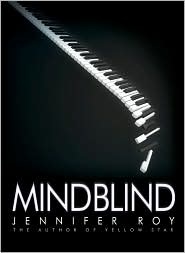 Mindblind by Jennifer RoyMarshall Cavendish, 2010Nathaniel is fourteen years old, enjoys video games and The Amazing Race, and plays keyboards in a band with his best friend and the girl he adores. He is also a homeschooled university graduate, very skilled at mathematics, and has Asperger syndome. Nathaniel's life goal is to be an official genius, which is what many people consider him to be due to his incredible memory and knowledge. However, according to a book he read when he was seven years old, someone must "accomplish something outstanding" (p. 14) before he or she can be considered a genius, so Nathaniel is determined to meet that objective as soon as he can. It remains to be seen if life will get in the way of his goal, and how he might manage to achieve it. Nathaniel has a typically complex teenage life: a girl he secretly has a crush on, divorced parents, not getting along with his father, and an embarrassing episode at a party. On top of that, he struggles to communicate with his family and friends due to his difficulty interpreting social cues, but he is an eminently likable person and quite self-aware. I enjoyed seeing the world from Nathaniel's perspective. The supporting characters have a lot going on as well. Nathaniel's mother was a highlight for me, and her interactions with Nathaniel were kind, firm, and she often exhibited a sense of humour. In many ways, Nathaniel's father is the villain of the book in that he steadfastly refuses to try to relate to Nathaniel in a manner that is outside his comfort zone or expectations. The developing relationships that Nathaniel has with his father's wife and his four-year-old half-brother were lovely to observe, and Nathaniel's best friend Cooper was solid as a rock. So many people in Nathaniel's life were supportive of him and his gradual awareness of this was heartwarming. Author Jennifer Roy has taken her experiences with her son (who, according to her website, also has Asperger syndrome and his highly gifted) and as a teacher and woven them into Mindblind. Thoughtful, humourous, illuminating, and highly recommended.
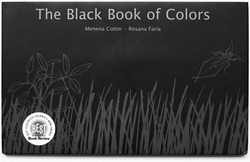 The black book of colors by Menena Cottin and Rosana Faria, translated by Elisa Amado
Groundwood Books/House of Anansi Press, 2006
More than any other book I've come across - certainly more than any other picture book I've encountered - The black book of colors gives those of us with the ability to see an idea of how we might perceive colours if we were blind. Printed entirely on black paper, a boy named Thomas describes what colours mean to him, beginning with, "Thomas says that yellow tastes like mustard, but is as soft as a baby chick's feathers."* A Braille translation is provided above the printed white text, and the page opposite the text and the Braille is comprised of an embossed representation of how Thomas interprets the color, in this case delicate feathers. The reader is able to read the text, feel how the same words are written in Braille, and feel the raised images.
Image from: http://erin-thefoolscapflyer.blogspot.com/2009/08/black-book-of-colors.html This isn't just a gimmick either, as the text is spare and evocative. Some connections seem more likely than others, such as brown smelling like chocolate, and other colours are very personal to Thomas, as with black feeling like his mother's hair falling on his face when she hugs him. The black book of colors takes colours into the realm of having meaning and associated emotion, well past mere visual processing of the electromagnetic spectrum.
*Book is not paginated.
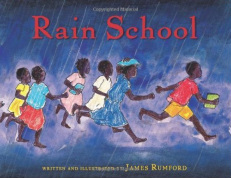 Rain school by James Rumford
Houghton Mifflin Harcourt, 2010
It is the first day of school for Thomas and the other children of his village in Chad. When Thomas and the other children arrive there is no school building, just a teacher. The students' first lesson is how to build a school from the ground up, as they do every year after the summer rainy season.
Rain school stems directly from James Rumford's experience as a Peace Corps volunteer in Chad and his knowledge shows. Many details, from the patterns of fabric to the local fauna, make it evident that he is familiar with the country. The backgrounds of the illustrations are predominantly shades of yellow and orange, which not only gave me a sense of heat but also provide an appropriately joyous atmosphere to the book.
It is difficult for many of us to imagine having to build a school every September in order to have a place to learn or teach. However, people in many parts of the world are not as lucky as we are and need to go above and beyond simply to learn, and Rain school is a delightful introduction to the topic.
|









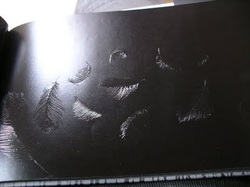

 RSS Feed
RSS Feed